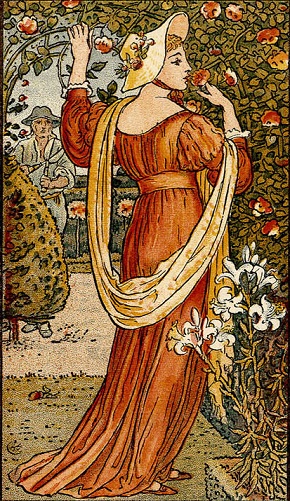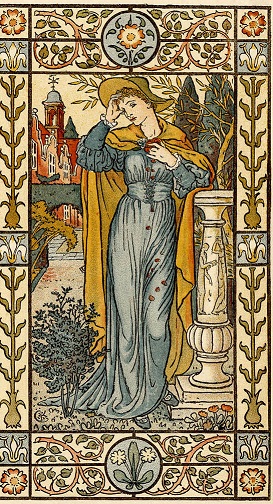Sprig of Thyme is a warning song of the British tradition, that warn the girls about the dangers of yielding to the charm of a false lover. “Sprig of Thyme” was probably already known in Shakespeare’s time. The ballade mingles lines with another warning song, Seeds of Love, making a classification difficult.
On the Irish side, on the other hand, titles like “The bunch of thyme” or “Let no man steal yout thyme” are more widespread (see)
Sprig of Thyme è una “warning songs” che mette in guardia le fanciulle sui pericoli di cedere al fascino di un falso innamorato. “Sprig of Thyme” era probabilmente già conosciuta ai tempi di Shakespeare. La ballata condivide pezzi di testo con un’altra warning song, Seeds of Love, rendendo ardua una classificazione.
Sul versante irlandese invece sono più diffusi titoli come “The bunch of thyme” o “Let no man steal yout thyme” (vedi)
SPRIG OF THYME
There are many text versions of “The Sprig of Thyme” with the double-sense, according to a charming language typical of the seventeenth-century living rooms that metaphorically speak of plants and flowers to indicate the issues of sex. The protagonist is a girl who complains because an unfaithful lover has stolen her thymus, but in this version proposed for listening, the woman does not regret much for her lost virginity as for being deceived by a “false lover”. So the thymus symbolizes the loss of innocence, the confident impulse of one who gives himself to love and instead finds the deception.
Ci sono molte versioni testuali di “The Sprig of Thyme” a doppio-senso, secondo un linguaggio vezzoso proprio dei salotti seicenteschi che metaforicamente parla di piante e fiori per indicare le questioni del sesso.
Protagonista una fanciulla che si lamenta perchè un amante infedele le ha rubato il timo, ma in questa versione proposta per l’ascolto, la donna non si rammarica tanto per la verginità perduta quanto per il fatto di essere stata ingannata da un “false lover”. Così il timo simboleggia la perdita dell’innocenza, lo slancio fiducioso di chi si dona all’amore e invece trova l’inganno.]
I O once I had thyme of my own (1), And in my own garden it grew; I used to know the place where my thyme(2) it did grow, But now it is cover’d with rue(3), with rue, but now it is cover’d with rue. II The rue it is a flourishing thing, It flourishes by night and by day; So beware of a young man’s flattering tongue, He will steal your thyme away. III I sowed my garden full of seeds; But the small birds(4) they carried them away In April, May, and in June likewise, When the small birds sing all day. IV In June there was a red-a-rosy bud(5), And that seem’d the flower for me; so oftentimes I snatched at the red-a-rosy bud, Till I gained the willow(6), willow tree. V O the willow, willow tree it will twist, the willow, willow tree it will twine; And so it was that young and false-hearted man When he gained this heart of mine. VI O thyme it is a precious, precious thing On the road that the sun shines upon; But thyme it is a thing that will bring you to an end, And that’s how my time has gone. | Traduzione italiana di Cattia Salto I Un tempo avevo il timo tutto per me, e cresceva nel mio giardino, conoscevo bene il posto dove il mio timo cresceva, ma ora è coperto dalla ruta, ma ora è coperto dalla ruta II. La ruta è un fiore che sboccia che sboccia notte e giorno, così state attente alla parlantina di un giovanotto, lui vi ruberà il vostro timo. III Ho seminato il mio giardino con tanti semi, ma gli uccellini li portavano via, in Aprile, Maggio e anche in Giugno quando gli uccellini cantano tutto il giorno. IV In giugno c’era una rossa rosa in boccio che credevo fosse il fiore per me e spesso ho strappato quel bocciolo di rosa finchè ho preso il salice. V Il salice, il salice si piegherà il salice, il salice si torcerà; e così fu che quel giovane falso innamorato si prese questo mio cuore. VI Oh il timo è una cosa preziosa, sulla via illuminata dal sole, ma il timo è una cosa che vi porterà a consumarvi, ed è così che il mio tempo è finito! |
NOTE
2) the thyme is the symbol of purity, understood as rectitude, to follow the right path (the one illuminated by the sun). The assonance between thyme and time is a trick, especially in the last stanza, the time of youth is short, so the thyme is a precious thing that should not be wasted
3) rue is a symbol of regret
4) the birds are the suitors
5) the red rose is the carnal passion, “unbridled passion” is the rosy flower of the woman, but also a euphemism to indicate a suitor who managed to get her virginity
6) Willow = fertility, but also sadness, pain and in this context it indicates an unhappy, abandoned love

NOTE
1) letteralmente “a mia disposizione”
2) [il timo è il simbolo della purezza, intesa come rettitudine, seguire la retta via (quella illuminata dal sole). Si gioca sull’assonanza tra thyme e time specialmente nell’ultima strofa, il tempo della giovinezza è breve, così il timo è cosa preziosa che non deve essere sprecata]
3) [la ruta è simbolo del rimpianto]
4) [gli uccellini sono i corteggiatori]
5) [la rosa rossa è la passione carnale, “passione sfrenata” è il roseo fiore della donna, ma anche un eufemismo per indicare un corteggiatore che è riuscito a ottenere la sua verginità]
6) Salice= fertilità, ma anche tristezza, dolore e in questo contesto sta proprio ad indicare un amore infelice, abbandonato

THE MALANDRINE VERSION
The text comes from the collection of Charles Lolley from Hemingbrough, East Yorkshire that in 1891 it was published in the Leeds Mercury Newspaper for a column given by Frank Kidson entitled “Notes on Old Tunes”: the final differs from the usual warning songs : finding another well-hung boyfriend!
LA VERSIONE MALANDRINA
Il testo proviene dalla collezione di Charles Lolley di Hemingbrough, East Yorkshire che nel 1891 venne pubblicata sul Leeds Mercury Newspaper per una rubrica tenuta da Frank Kidson dal titolo “Notes on Old Tunes”, il finale si discosta però dalle solite warning songs propendendo per una versione “consolatoria”: trovarsi un altro fidanzato ben dotato!
I
Come all you pretty fair maids,
That are just in your prime,
I would have you weed your garden clear,
And let no one steal your thyme(1).
II
I once had a sprig of thyme,
It prospered both night and day,
By chance there came a false young man,
And he stole my thyme away,
III
Thyme it is the prettiest flower
That grows under the sun,
It’s time to brings all things to an end,
So now my time (1) runs on.
IV
Now my old thyme it is dead,
I’ve no room for any new,
For in that place where my old thyme grew,
Has changed into a running rue(2).
V
I’ll put a stop to that running rue,
And plant a fair oak tree(3),
Stand you up, stand you up, you fair oak tree,
And do not wither and die.
VI
It’s very well drinking ale,
And it’s very well drinking wine,
But it’s far better sitting by a young man’s side,
That has won this heart of mine.
NOTE
1) the thyme is the symbol of innocence, understood as rectitude and coherence. It is played on the assonance of the words thyme -time
2) rue is a symbol of regret 3) the 5th strophe had been “censored” by the publication in the he Leeds Mercury Newspaper because probably considered “too saucy”, taken from “The New Penguin Book of English Folk Song” Steve Roud & Julia Bishop
Traduzione italiana di Cattia Salto
I
Venite tutte voi fanciulle graziose e belle
che siete nell’età della giovinezza,
vorrei che teniate il vostro giardino pulito
chè nessuno rubi il vostro timo (tempo).
II
Un tempo avevo il mio rametto di timo,
e prosperava notte e giorno,
disgraziatamente arrivò un giovanotto falso
e mi portò via il timo.
III
Il timo è il fiore più bello
che cresca sotto il sole,
è il tempo che volge ogni cosa alla fine,
così adesso il mio tempo è scaduto.
IV
Il mio vecchio timo è morto
e non ho posto per quello nuovo,
perchè dove il mio vecchio timo cresceva,
si è sostituita la ruta strisciante.
V
Metterò fine all’espandersi della ruta
e pianterò una forte quercia,
ergiti, ergiti tu forte quercia,
non avvizzire e morire!
VI
Va bene bere birra,
ed è ancora meglio bere vino,
ma è molto meglio sedersi accanto ad un giovanotto
che abbia vinto questo mio cuore.
NOTE
1) [il timo è il simbolo dell’innocenza, intesa come rettitudine e coerenza. Si gioca sull’assonanza delle parole thyme -time]
2) [la ruta è simbolo del rimpianto]
3) [ la V strofa era stata “censurata” dalla pubblicazione sul giornale perchè considerata probabilmente “troppo spinta“, tratta da “The New Penguin Book of English Folk Songs” Steve Roud & Julia Bishop]
LINK
http://ontanomagico.altervista.org/fiori-erbe-buone-maniere-e-pruderie-nelle-antiche-ballate.html
The Search For Five Finger Frank
http://www.joe-offer.com/folkinfo/songs/6.html
http://www.joe-offer.com/folkinfo/songs/85.html http://www.theguardian.com/music/2010/may/23/folk-fishermans-friends http://mysongbook.de/msb/songs/r_clarke/thyme.htm
